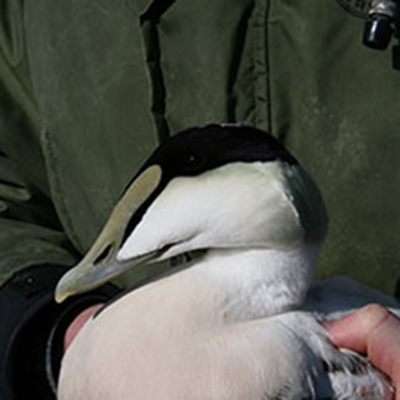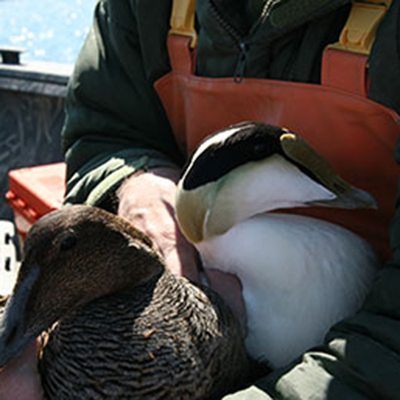Examining Mercury Concentrations in Common Eiders and Their Food Items
In North America and Europe, sea ducks have become important indicators of ecological health and inshore marine pollution. Common Eiders are the largest ducks in the northern hemisphere and inhabit marine environments throughout all stages of their life cycle. Their life history characteristics and long life span, which may exceed 20 years, make them a sentinel species for contaminant monitoring in coastal marine habitats.
Project Goals

The main objective of this study was to compile blood mercury data from past and recent sampling efforts to help identify spatial patterns of mercury accumulation in eiders throughout the northeastern United States. We also analyzed mollusk samples to determine if there was a consistent relationship between contaminant levels in eiders and their food items throughout the study area.
Project Components

Between 1998 and 2014, we collected blood samples from nearly 150 individual eiders representing 14 capture locations within Maine, Massachusetts, and Rhode Island. Birds were captured using a system of floating mist nets and decoys deployed on winter staging areas and near breeding islands. After taking a small blood sample each bird was banded, weighed, and assessed for overall health condition before being released. Blue mussels, which make up the bulk of a typical eider’s diet, and periwinkle snails, were collected by hand from shallow intertidal areas near capture locations in Massachusetts and Maine. Small amounts of blood from each bird, along with soft tissue samples from the mollusks, were analyzed for total mercury concentrations at BRI’s Wildlife Mercury Research Lab.
2016 Project Update

With the exception of birds sampled in Plum Island Sound, MA, concentrations of total mercury were relatively low and were similar to mean values reported for eiders in other locations. Mean mercury levels in eiders from Plum Island Sound were nearly three times higher than any blood mercury concentrations reported for common eiders. Blue mussels and periwinkle snails from Boston Harbor, MA, were significantly higher in mercury than those from Plum Island Sound and locations in Maine. We found a consistent relationship between mercury levels in eider blood and food items in Maine and Plum Island Sound, MA, but not in Boston Harbor. This may suggest that eiders in Boston Harbor are selecting a different food source than blue mussels in that area. With our next research steps, we hope to use stable isotope analysis to help determine differences in food sources and foraging strategies in these different locations. Key findings from this study have recently been accepted for publication in Marine Pollution Bulletin (Meattey et al. 2014, Marine Pollution Bulletin, in press).
Project Collaborators
This project was a collaborative effort involving several key individuals and organizations.
- Lucas Savoy, Biodiversity Research Institute
- Dustin Meattey, Biodiversity Research Institute
- Nancy Pau, U.S. Fish and Wildlife Service, Parker River NWR
- Kate O’Brien, U.S. Fish and Wildlife Service, Rachel Carson NWR
- Josh Beuth, Rhode Island Department of Environmental Management
- Chris Dwyer, U.S. Fish and Wildlife Service
- Randy Mickley, USDA/APHIS Wildlife Services
- Glenn Olsen, USGS, Patuxent Wildlife Research Center


